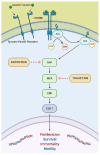The Role of Histology-Agnostic Drugs in the Treatment of Metastatic Castration-Resistant Prostate Cancer
- PMID: 35955671
- PMCID: PMC9369092
- DOI: 10.3390/ijms23158535
The Role of Histology-Agnostic Drugs in the Treatment of Metastatic Castration-Resistant Prostate Cancer
Abstract
Precision medicine has opened up a new era in the development of anti-cancer agents that is focused on identifying biomarkers predictive of treatment response regardless of tumor histology. Since 2017, the Food and Drug Administration has approved six drugs with histology-agnostic indications: pembrolizumab (both for tumors with the mismatch-repair deficiency (dMMR)/high microsatellite instability (MSI-H) phenotype and for those with the high tumor mutational burden (TMB-H) phenotype), dostarlimab (for dMMR tumors), larotrectinib and entrectinib (for tumors harboring neurotrophic tyrosine receptor kinase (NTRK) fusions), and the combination of dabrafenib plus trametinib (for BRAF V600E-mutated tumors). The genomic alterations targeted by these antineoplastic agents are rare in metastatic castration-resistant prostate cancer (mCRPC). Furthermore, only a small number of mCRPC patients were enrolled in the clinical trials that led to the approval of the above-mentioned drugs. Therefore, we critically reviewed the literature on the efficacy of histology-agnostic drugs in mCRPC patients. Although the available evidence derives from retrospective studies and case reports, our results confirmed the efficacy of pembrolizumab in dMMR/MSI-H mCRPC. In contrast, few data are available for dostarlimab, larotrectinib, entrectinib, and dabrafenib-trametinib in this subset of patients. Large, multi-institutional registries aimed at collecting real-world data are needed to better comprehend the role of tissue-agnostic drugs in mCRPC patients.
Keywords: BRAF V600E; MSI-H; NTRK; TMB-H; dMMR; histology-agnostic; prostate cancer.
Conflict of interest statement
The authors declare no conflict of interest.
Figures




Similar articles
-
Target-Driven Tissue-Agnostic Drug Approvals-A New Path of Drug Development.Cancers (Basel). 2024 Jul 13;16(14):2529. doi: 10.3390/cancers16142529. Cancers (Basel). 2024. PMID: 39061168 Free PMC article. Review.
-
[Current Status and Challenges in Tumor Agnostic Treatment].Gan To Kagaku Ryoho. 2023 Jun;50(6):657-661. Gan To Kagaku Ryoho. 2023. PMID: 37317595 Japanese.
-
A real-world experience of pembrolizumab monotherapy in microsatellite instability-high and/or tumor mutation burden-high metastatic castration-resistant prostate cancer: outcome analysis.Prostate Cancer Prostatic Dis. 2025 Mar;28(1):138-144. doi: 10.1038/s41391-024-00799-y. Epub 2024 Feb 10. Prostate Cancer Prostatic Dis. 2025. PMID: 38341460
-
Tumor-Type Agnostic, Targeted Therapies: BRAF Inhibitors Join the Group.Acta Med Acad. 2022 Dec;51(3):217-231. doi: 10.5644/ama2006-124.392. Epub 2022 Dec 30. Acta Med Acad. 2022. PMID: 36799315 Free PMC article. Review.
-
Application of histology-agnostic treatments in metastatic colorectal cancer.Dig Liver Dis. 2022 Oct;54(10):1291-1303. doi: 10.1016/j.dld.2022.05.013. Epub 2022 Jun 11. Dig Liver Dis. 2022. PMID: 35701319 Review.
Cited by
-
Androgen Metabolism and Response in Prostate Cancer Anti-Androgen Therapy Resistance.Int J Mol Sci. 2022 Nov 4;23(21):13521. doi: 10.3390/ijms232113521. Int J Mol Sci. 2022. PMID: 36362304 Free PMC article. Review.
-
Immunotherapy for Prostate Cancer: A Current Systematic Review and Patient Centric Perspectives.J Clin Med. 2023 Feb 11;12(4):1446. doi: 10.3390/jcm12041446. J Clin Med. 2023. PMID: 36835981 Free PMC article.
-
Tracing the Evolution of Sex Hormones and Receptor-Mediated Immune Microenvironmental Differences in Prostate and Bladder Cancers: From Embryonic Development to Disease.Adv Sci (Weinh). 2025 Apr;12(13):e2407715. doi: 10.1002/advs.202407715. Epub 2025 Feb 25. Adv Sci (Weinh). 2025. PMID: 40007149 Free PMC article. Review.
-
Androgen Receptor Signaling Inhibition in Advanced Castration Resistance Prostate Cancer: What Is Expected for the Near Future?Cancers (Basel). 2022 Dec 9;14(24):6071. doi: 10.3390/cancers14246071. Cancers (Basel). 2022. PMID: 36551557 Free PMC article. Review.
-
Combinations of treatments based on radiotherapy or radionuclides to enhance immunotherapy efficacy in advanced prostate cancer: a systematic review.J Cancer Res Clin Oncol. 2025 Jun 23;151(6):195. doi: 10.1007/s00432-025-06245-3. J Cancer Res Clin Oncol. 2025. PMID: 40550923 Free PMC article.
References
-
- De Bono J.S., Oudard S., Ozguroglu M., Hansen S., Machiels J.-P., Kocak I., Gravis G., Bodrogi I., Mackenzie M.J., Shen L., et al. Prednisone plus Cabazitaxel or Mitoxantrone for Metastatic Castration-Resistant Prostate Cancer Progressing after Docetaxel Treatment: A Randomised Open-Label Trial. Lancet. 2010;376:1147–1154. doi: 10.1016/S0140-6736(10)61389-X. - DOI - PubMed
Publication types
MeSH terms
Substances
LinkOut - more resources
Full Text Sources
Research Materials

